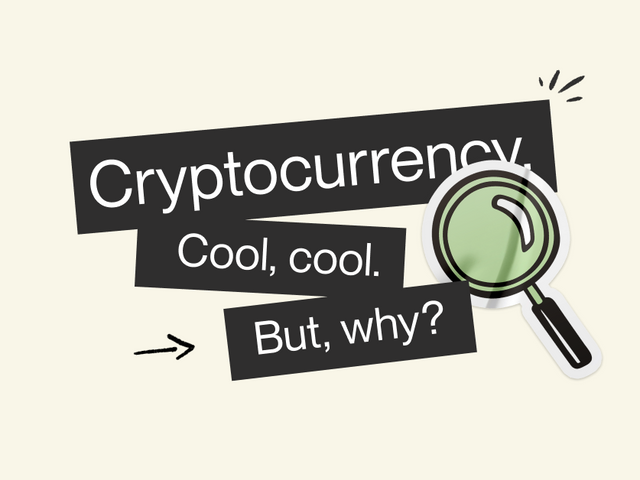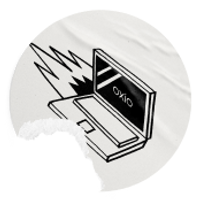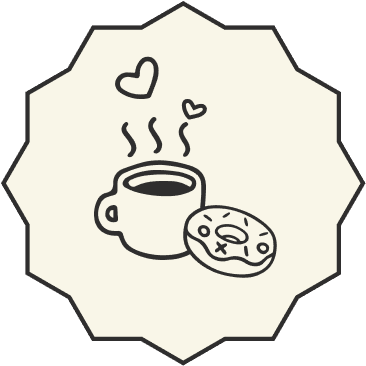Edit, April 2023: So, we've decided to remove cryptocurrency as a payment method for the time being. We'll see how we feel about enabling them again in the future, but, for now, we'll resort to more traditional payment methods.
Starting my research with Cryptocurrency Investing For Dummies is probably a pretty dead giveaway at my lack of knowledge about whatever the hell cryptocurrencies are and why everyone seems to be talking or mumbling or wondering about them. But, hey, we all start somewhere. So, let’s start here.
What even are cryptocurrencies?
The Dummies definition of cryptocurrency is: “a new form of digital money.”1 Wait, wait, wait. A new form of digital money? There are other forms of digital money? Well, kind of.
Okay rabbit hole, let’s do this.
So, digital electronic currencies have been around for a while.
When was the last time you paid for something with actual cash money? We can’t remember either. Electronic versions of currency already dominate most countries’ financial systems. In Canada, for example, there are around 106.93 billion dollars worth of banknotes in circulation2. Which is only a fraction of the overall money supply. The rest is held in electronic form.
What’s the difference between digital currency and the electronic money in most of our bank accounts? Well, right now, you could go to an ATM and turn the numbers that represent your bank balance into actual dolla’ dolla’ bills. True digital currency never takes physical form. It’ll always just be numbers on a computer network.
Now, our transition to electronic money may sound like a gateway to cryptocurrencies, but us letting go of physical cash wasn’t exactly step one.
The gold standard. (No really we need to talk about it.)
The gold standard. It sounds fancy, but it was a pretty straightforward monetary system that linked the value of a country’s currency to gold3. A government would commit to buying and selling gold at a fixed price4. That fixed price was then used to determine the value of the currency. (The how is a bit complicated for an article focusing on cryptocurrencies, but you can read all about it here or here.) To ensure a country’s currency maintained its value, the government issuing the currency had to hold an amount of gold equal to the cash in circulation (this is called the money supply). That’s it. Its rigidity and finiteness made for very stable currencies, but ultimately couldn’t keep up with the growth and globalization of modern economies. Canada stopped using the gold standard in 1929. Britain stopped in 1931, and the U.S. in 1933. The gold standard is no longer used by any government5.
The gold standard didn’t die a sudden death. As World War II was coming to an end, the Bretton Woods Agreement, which would be the framework for the global currency markets until 1971, was agreed upon. The Bretton Woods system valued all national currencies in relation to the U.S. dollar, which became the dominant reserve currency. The dollar, in turn, was convertible to gold at the fixed rate of $35 per ounce6. So, the global financial system continued to operate on a gold standard. Ish.
There’s a lot more to the story, but we’re not getting into the details because we really want to get to cryptocurrencies. So, fast forward to 1971 when the U.S. completely replaced what was left of the gold standard with fiat money.
Fiat money. Or “trust us, we know what we’re doing money”.
Fiat money is a government-issued currency that isn’t backed by a physical commodity, such as gold. So what’s it backed by? The government that issued it. The value of fiat money is based on the supply and demand and the stability of the country’s government7.
If that sounds sketchy to you…well, it kind of is. Fiat money definitely has its cons, but it has few pros too. Fiat money gives central banks control over their supply, which means they have the power to manage variables such as credit supply, liquidity, and interest rates. Theoretically, it also gives governments greater flexibility to manage their own currency, set monetary policy, and stabilize global markets while allowing for fractional reserve banking. (Which means that only a fraction of bank deposits are backed by actual cash in the vault.)
Yes, you read all that right. A fiat currency only really has value because a government says it does. And that means it can lose value due to inflation or if people lose faith in a government.
And people lose faith in governments all the time. In May 2020 Argentina defaulted on its external debt for the 9th time since its independence in 1816. Again, we’re not going to get into the details here. But we will say Argentina has been at the mercy of inflation and debt from external sources (the established financial institutions) for a pretty long time. That, mixed with some questionable decisions (like just printing more money), a drought and a pandemic have made it impossible for the Argentinian peso to stabilize. Argentina’s track record means that there isn’t a lot of faith left in its government, which makes borrowing money to stabilize its currency expensive. And the cycle continues8.
Now you’re probably thinking that that could never happen here in Canada. Well, right now inflation here at home is hovering somewhere between 5 and 7% and there is a lot of uncertainty to come. If our national currency was the Bitcoin, would that really make a difference? El Salvador is kind of testing that alternate reality for us right now. And we’ll talk all about it in a few paragraphs. But, for now, we’re just going to wrap this section up.
As our confidence in central banks keeping everything stable continues its downward trend (thanks to deregulation in the U.S.), cryptocurrencies such as Bitcoin have emerged to challenge fiat money.
What even are cryptocurrencies. Take two.
Let’s bring back the Dummies definition: “a cryptocurrency is a new form of digital money.” Great. Except that now we know a little more and can probably come up with a better definition.
How about: A cryptocurrency is a digital currency not issued by a central authority, rendering them theoretically immune to government interference or manipulation. In place of a trusted third party, transactions are verified and maintained by a decentralized system using blockchain technology.
Okay, so we don’t know all of that yet. But we will soon.
So, why haven’t we all jumped on the cryptocurrency bandwagon? Again, they’re new. Our centralized banking system has been around for a while and for the most part it’s a tried, tested and trusted system. But the cons are starting to pile up.
- Payment systems such as credit cards and wire transfers are outdated.
- A bunch of middlemen like banks and brokers take a cut for most transactions.
- Financial inequality is growing around the globe.
- Around 3 billion people can’t access financial services. Three. Billion. People9.
Fine. We get it (and we agree): no one likes banks. But we do, for the most part, trust them. Why are we all so trusting of a for-profit system doing what’s best for our money? Well, they’re backed and regulated by the government.
But the current system, regulated or not, still puts the power and control of our money in the hands of a very few. But, but, but, at least we understand this system. Cryptocurrencies haven’t earned our trust quite yet.
The best way to learn to trust something new, is to understand it. So, let’s start with the first ever cryptocurrency: Bitcoin. Satoshi Nakamoto (not the person’s real name) created Bitcoin in 2008 and defined it as “a Peer-to-Peer Electronic Cash System”10. The idea behind Bitcoin was to give people control over their money by eliminating trusted third parties (banks and governments). And it accomplished this through a technology that began taking shape in 1991.
That technology is what sets cryptocurrencies apart. It’s why we can and should trust them. And it’s called the blockchain.
Rabbit hole. Take two.
What is the blockchain and why does it matter?
The blockchain is what makes cryptocurrency such a powerful idea and to really understand it, we can’t limit it to the realm of cryptocurrencies. But, for this article, that’s exactly what we're going to do.
The blockchain is a decentralized record keeping system outlined in 1991 by Stuart Haber and W. Scott Stornetta11. These guys wanted to implement a system where document timestamps couldn’t be tampered with. And they succeeded.
The blockchain is what makes cryptocurrency such a powerful idea.
Using the blockchain for cryptocurrencies was, well, pretty friggin’ smart. Instead of keeping records of all financial transactions in one centralized location (like our current system does), the blockchain stores copies of all financial transactions in chunks (or blocks) on all the computers connected to it. Once a block is full, it’s locked, timestamped and a new block is created and added to the previous one creating an irreversible timeline (or chain) that’s visible to everyone. This peer-to-peer network guarantees the accuracy and security of every transaction without the need for a trusted third party.
So, block + chain = blockchain.
To sum it all up, a blockchain allows us to record, store and distribute digital information that cannot be altered, deleted or destroyed. And it stores it across several locations. This creates redundancy and keeps the data honest. If someone tries to alter that data in one location, all the other locations would cross-reference each other and call out the incorrect info. Accurate. Irreversible. Traceable.
Okay okay, but what about privacy? Well, in the case of cryptocurrency, every coin is traceable, but the identity of the owner is protected by encryption12. Anonymous. Transparent.
Now, where things really start to get interesting is that, sure, a blockchain can hold a list of financial transactions but it can also hold legal contracts, IDs, inventory, and copyrights. And that is a big deal for the future of everything, including the internet. It’s also an article for another day.
Okay, back to cryptocurrencies.
Let’s recap. Cryptocurrencies are a new electronic cash system that’s fully peer-to-peer, without the need of a trusted third party like a bank or government to validate transactions. They’re anonymous. They’re transparent. And the more people use them, the more secure they get. So, in short, pretty much the opposite of everything bad about our current financial institutions.
But just because it’s the way we’ve always done it, doesn’t necessarily mean it makes sense today. Take the internet in Canada. It’s controlled by a handful of big telco companies. They decide what it costs. They decide who has access to it. They control it. And when all that control is in the hands of a few, corruption happens. Our financial system is pretty similar. If oxio is trying to change the way people think of the internet, cryptocurrencies want to change the way people think about money by redistributing the control of our finances to, well, us.
But just because it’s the way we’ve always done it, doesn’t necessarily mean it makes sense today.
But, I already control my money. Don’t I? Well, kind of. In the current system, the central banks and the government have a lot more control over our money than we’re comfortable admitting. If you trust your bank (lol) and your government, that’s great. But at any point, your government can freeze your bank account and deny you access. Every time you make a transfer, your bank or a payment service takes a cut. And don’t forget those bank fees that seem to just keep going up and up and up. (Coincidentally, so do the profits of the big banks.) With cryptocurrencies, all of that has been rethought and redistributed more equally.
The unequal distribution of wealth and the access to it is a big problem. A large portion of the world has limited or no access to financial services. Cryptocurrencies want to fix this by letting anyone with a mobile phone access these services. And it could work. Right now there are more people in the world with a mobile phone than a bank account.
So let’s say I’m convinced. Which cryptocurrency do I choose?
Well, we don’t know.
What we do know is that there are over 16,000 cryptocurrencies out there13. Among the big ones are Bitcoin, Dai, Dogecoin, Ethereum, Litecoin, Ripple, Solana, USDC... And each of them was created to facilitate a different agenda. Bitcoin to replace national currencies. Ethereum to facilitate contracts and NFTs (it can be argued that Ethereum isn’t even a cryptocurrency, but this article is already complicated enough). Maricoin to fight homophobia. In other words, crypto is still figuring itself out. Add to that that it’s pretty easy to create a new one and you’re gonna get a lot of them. All in all, a few cryptocurrencies are trying to solve real ideological, technical, social or political problems. All the others are just trying to make a quick buck14.
Time will tell which are which.
Okay, we’re getting closer to real life.
Cryptocurrencies are being tried and tested around the world. Sure, some people are using the crypto market to make money. But others are seeing what happens when crypto is used as money (Microsoft, Twitch, Whole Foods, oxio, Starbucks-ish, etc.) or even as a national currency.
Why don’t countries make their own digital currency?
In 2021 El Salvador adopted Bitcoin as its legal tender15. Why did El Salvador decide to do this? Well, a large part of the population depends on money transfers from outside the country. This can cost up to 50% of the value of the transfer, plus the cost and complexities of actually collecting the physical money–almost 70% of Salvadorians do not have a bank account. Bitcoin allows more people to access financial services, practically eliminates transaction fees, and reduces the country's reliance on the US Dollar.
It’s still waaaaay too early to tell if El Salvador’s Bitcoin experiment will work. The launch wasn’t even close to perfect. Many Salvadorians took the $30 worth of Bitcoins they got when they signed up for the government issued e-wallet, Chivo, and immediately cashed them in for US Dollars. Others claim their identities (and their $30) were stolen through Chivo. And, to no one's surprise, the established institutions aren’t all that thrilled with what they’re considering as a pretty epic gamble16.
Will other countries follow in El Salvador’s footsteps? Well, Ukraine just, and by just we mean on February 18, 2022, legalized cryptocurrencies–taking a first step towards actually regulating them17. And other countries are slowly opting to introduce digital versions of their currency. i.e. national currencies regulated by the government and central banks.
Nigeria recently became the largest economy in the world to introduce a digital currency (eNaira). Mexico is planning to launch a digital currency by the end of 2024. The Bank of Canada has also been looking into a digital loonie18.
All of these approaches are exploring the future of money and how we interact with it. Each one has the potential to move us closer to a more equal and decentralized financial system.
So, oxio accepts cryptocurrency because they have a lot in common with cryptocurrencies?
Wait. Did we already mention that we’re now accepting cryptocurrency? Because we are.
And, yeah, one of the reasons we’re accepting crypto is because we do have a few things in common with it. But we also think it’s the future of money. Sure, it’s new compared to the current system and that means there’s still a lot to figure out–like how to replace a system as established and ubiquitous as the world’s financial system.
We’re not blindly jumping into the cryptocurrency world. But we are jumping. We’ve partnered with Coinbase, a secure, protected, and respected cryptocurrency platform and are now accepting cryptocurrency. Like everything we do, we’re going to keep adapting and iterating on our cryptocurrency policy.
It’s important for us to support cryptocurrency because we believe in the transparent, decentralized, world it could create. Like the internet, we think it’ll provide equal access to opportunities to people around the world. And that’s something we want to be a part of.
Researched and written over the weekend by David. (My brain hurts.) Adapted into French in under 5 hours by Danilo. (He also found the time to point out my many, many typos.)
1 What Is Cryptocurrency? - dummies
2 Value of Canadian banknotes in circulation 2020 | Statista
3 What Is the Gold Standard?
4 Gold Standard | The Canadian Encyclopedia
5 What Is the Gold Standard?
6 What Is the Gold Standard?
7 Fiat Money Definition
8 Argentina's Economic Crisis and Default
9 What Is Cryptocurrency? - dummies
10 Bitcoin: A Peer-to-Peer Electronic Cash System
11 Blockchain Definition: What You Need to Know
12 ibid.
13 With so many cryptocurrencies, why do any of them have value? | CBC News
14 Alternative Currencies: Why are there so many cryptocurrencies? - Quora
15 El Salvador's law: a meaningful test for Bitcoin
16 Can Bitcoin Be a National Currency? El Salvador Is Trying to Find Out. - WSJ
17 Ukraine trades more crypto than fiat currency. Now it's legalized assets like Bitcoin | Fortune
18 Government-issued digital currency could be the coin of the future | CBC Radio








